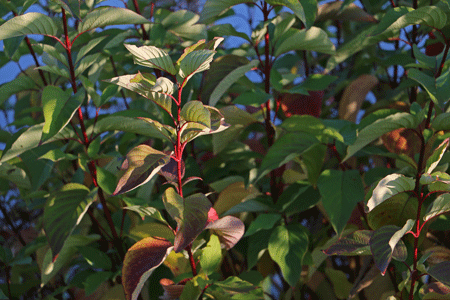Colourful cornus – the dogwood - is the HTA’s Plant of the Moment for November.
These reliable hardy shrubs provide a leafy backdrop to summer flowers before transforming into a rainbow of autumn colours that drop away to reveal brilliant wand-like stems.
This seasonal transformation is just the start of a host of new planting partnerships that can be enjoyed right through until spring. During winter the brightly coloured stems of dogwoods catch sunlight to create dazzling displays. Small gardens might only have space for a single plant, so position it where the low piercing winter sunlight will shine through, catching stems in its spotlight.
Many shrubby dogwoods also carry clusters of tiny flowers through summer. These are usually creamy-white, often leading to the formation of dense heads of white berries in autumn.
Shrubby dogwoods grow well in almost any soil, even moist sites and heavy clay ground. They’ll do best in a sunny position, but will tolerate some shade. Contrasting colours always work well when developing planting combinations, so consider planting groups of two or more together.
Try planting dogwoods in large patio containers to create seasonal displays with a difference, under-planting them with low winter bedding, leafy perennials and small shrubs.
There are dozens of plants to choose from as partners for dogwoods. Some can be planted as a background to show off the stems, while others provide flowering companions through winter. Low growers like bergenia and heuchera, can be planted in clumps to carpet the ground, or underplant with early flowering bulbs like snowdrops, crocus and narcissus.
Popular dogwood varieties for the garden
For summer foliage and winter stems:
Cornus alba varieties – such as ‘Elegantissima’, ‘Aurea’, ‘Spaethii’, and Siberian dogwood ‘Sibirica’
Small trees with attractive flowers and foliage:
Cornus controversa ‘Variegata’ (AGM)
For winter flowers:
Cornus mas – dainty yellow flowers in winter, red fruits in late summer
Planning and planting advice for your information centre
- Where dogwoods are specifically grown for their winter stems, they’ll need annual pruning. This is simply done by cutting all stems down to their woody base close to ground level every spring. This encourages new stems to develop during the year, and it’s these you’ll enjoy the following winter.
- Try taking hardwood cuttings. Once leaves have fallen, lengths of stem can be prepared and inserted into slits in the ground filled with gritty sand. Heal in firmly and keep watered if conditions are dry. Cuttings should root over spring/summer and produce well rooted new plants by next autumn. They’re fun to take, so check online gardening websites (like the RHS) for full advice on taking hardwood cuttings.
Planting partners for winter displays
· Ajuga varieties
· Brachyglottis ‘Sunshine’
· Euphorbia varieties
· Snowdrops (Galanthus varieties)
· Winter Flowering Jasmine (Jasminum nudiflorum)
Photo - © Adam Pasco Media